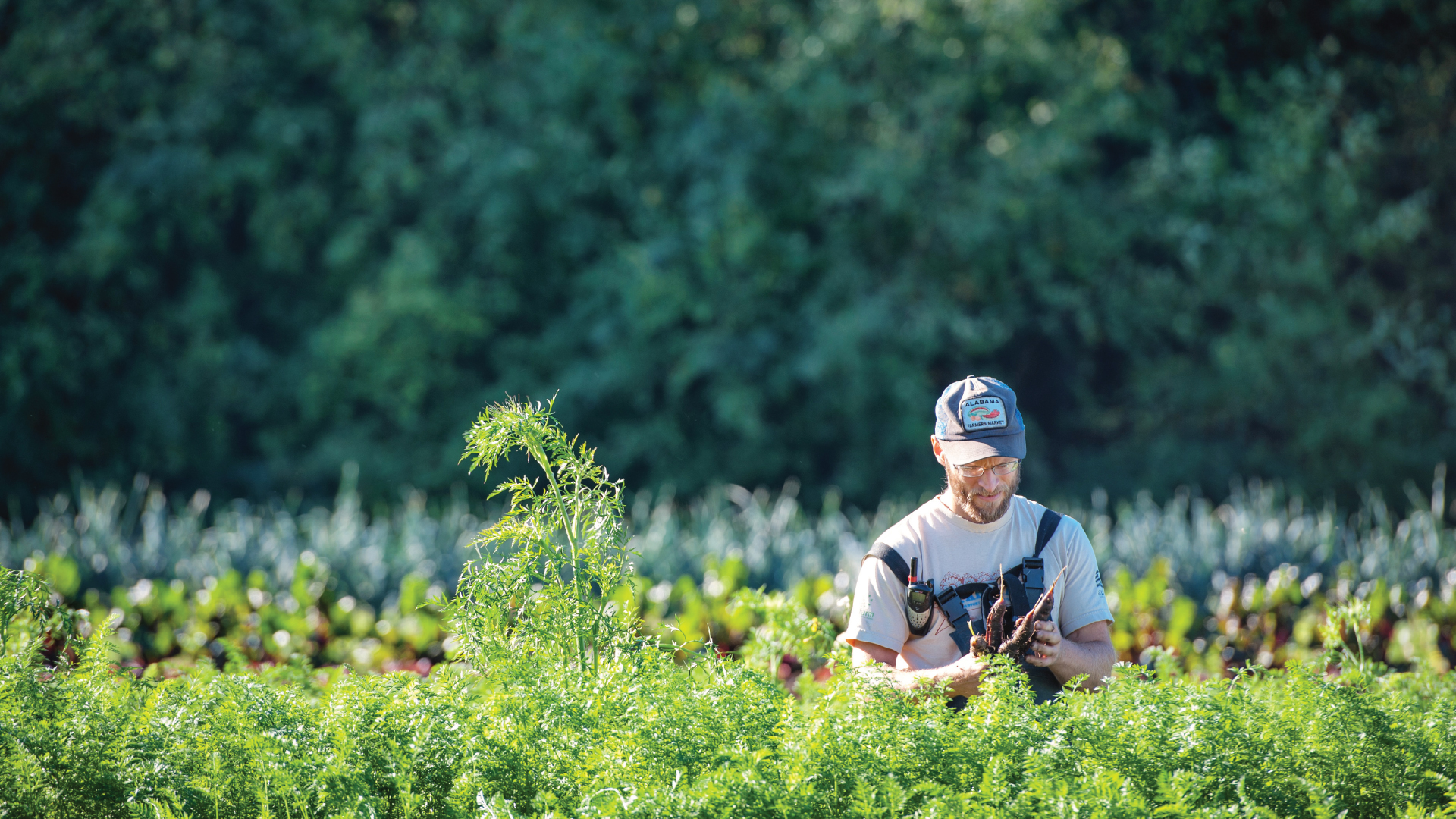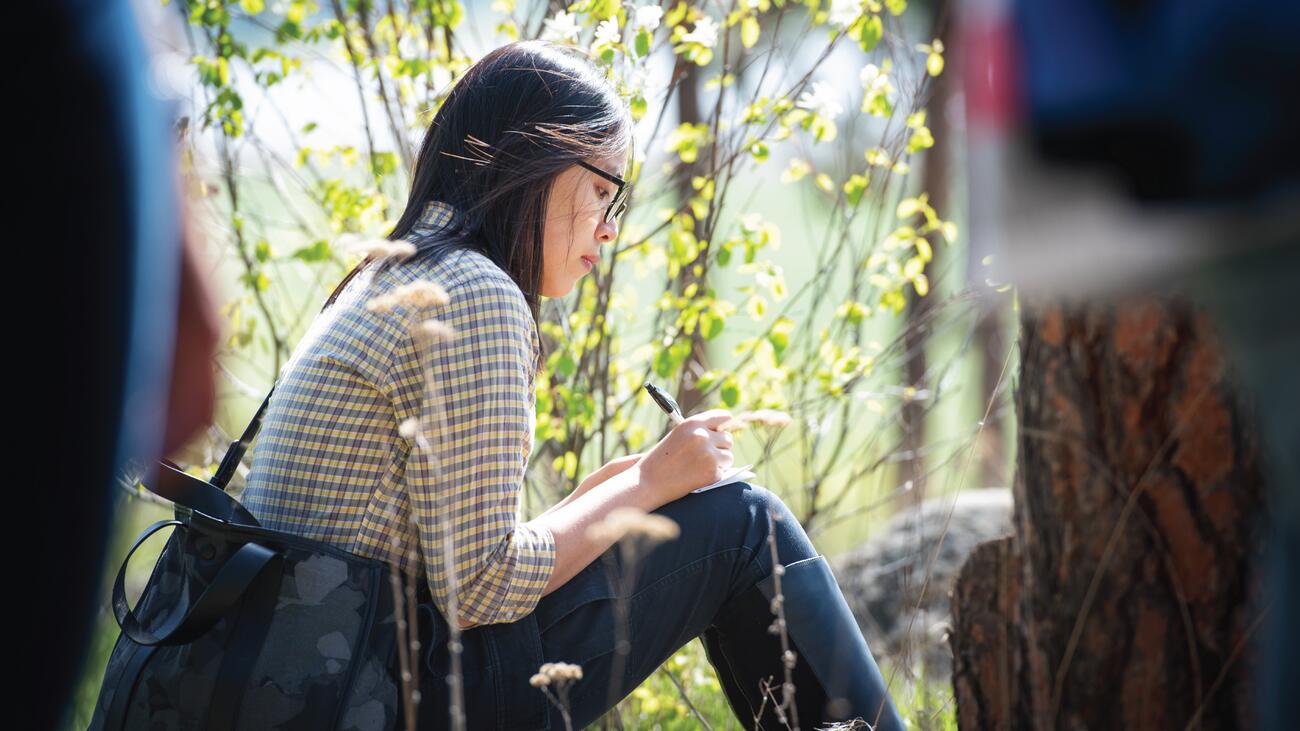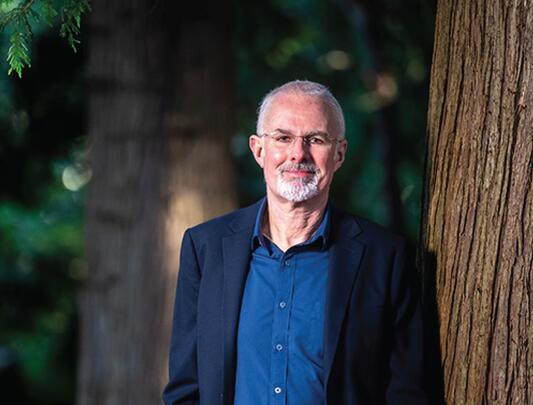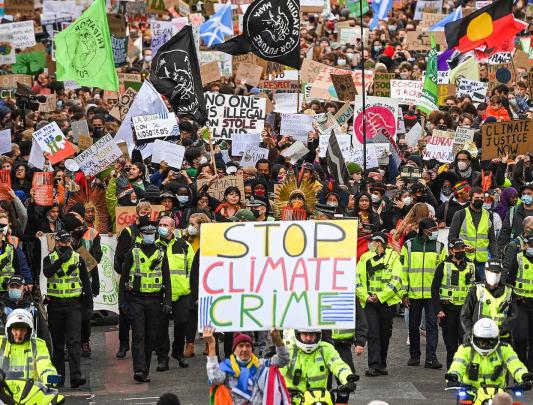3 calming ways to work through your climate worries
UBC experts share meditative practices for mitigating your climate-related stress.
I grew up on a steady diet of nature documentaries, staring wide-eyed as whales finned through ocean waves and fish swarmed within vibrant reefs. As I grew older, the filmmakers’ tones shifted from marvellous to cautionary — look closely, this might be the last time.
Between middle school and university, climate change shifted from a murky future concept to an uptick in “once-in-a-lifetime” climate disasters splashed across my newsfeeds. Last year, I went scuba diving for the first time with my family. In the sea, my mind returned to the vivid underwater gardens I had seen on screens; in front of me, all I saw were phantom forests of coral, their bone-white fingers frozen in the surf.
It’s easy to become disheartened at the state of the planet, to feel overwhelmed, to let anxiety and apathy settle under your skin. I’ve been there. But over time, I’ve realised that my pessimistic feelings don’t help the earth or my state of mind.
I’ve learned that in order to help, I need to process my climate worries and be intentional about what I can do. It’s a hard balance to strike. I recognise that not everybody has the privilege of taking a step back and engaging in more meditative forms of climate action. Personally, however, I find that I am more motivated and effective when I work through my emotions.
If you’re like me, sometimes you need to be shaken from your doom. You want to help, but you don’t want to be drained. So, what can we do?
I posed this question to three UBC faculty and staff in different fields, each of whom recommended a tangible, calming, and restorative method for processing climate concerns: experimenting with climate writing, going on nature walks while contributing to citizen science, and volunteering at the UBC Farm. While anxiety is an understandable response to climate change, we can choose to work through it. I hope you consider engaging in one (or all three) of these grounding practices.
Explore the impossible and build resilience with climate writing

Climate writing is for everyone, says author and UBC creative writing professor Alix Ohlin. She generally defines climate writing as pieces that centre the non-human, deal with relationships and intersections between beings, and recognize the reality of anthropogenic (human-caused) climate change.
You don’t need to write a novel like Octavia Butler’s Parable of the Sower to reap the benefits of climate writing (though you can if you’d like). Climate writing is more about being attentive to the world — in all its complexity and contradiction — and writing a response of any length.
“Climate writing brings people into an imaginative space where we can think about possibilities,” Ohlin says. Confronting the immensity of climate change can be overwhelming; however, examining facets of it within the realm of fiction allows you to entertain the impossible and uncover new ways of thinking.
Climate writing can also help you grapple with your feelings around climate change and free you to explore and play with alternate realities, unencumbered by anxiety.
Ohlin puts it this way: “Even for people who are like policy workers or scientists, climate fiction is a really important imaginative tool… it builds our resilience and our empathy and our sense of what is possible for all of us going forward.”
A good way to dip your toes in climate writing is to try Ohlin’s Everyday Life project, the first assignment in her undergraduate course on the topic. For a set period of time (a month, for example), commit to a daily climate-related practice that helps you observe your environment. Afterwards, write about your experience.
The practice can be anything, from bringing a reusable bottle everywhere, to taking a daily picture of the sky, to tracking how the seasons change in your neighbourhood. One student in Ohlin’s class read an article about Indigenous-led climate activism each day and came away with a renewed sense of inspiration and hope. You can also journal, write poetry, send letters to elected officials, or pen stories.
Instead of recoiling from reality, experimenting with climate writing enables you to face your emotions and open your mind to alternative ways of moving forwards.
Contribute to citizen science while going on mindful nature walks

If you prefer a more physically active method to process your climate worries, consider going on a guided (or solo) nature walk.
UBC alum and former UBC Climate Action Engagement & Outreach Coordinator Aldona Czajewska (BSc’17) has plenty of experience running such biodiversity workshops and walks. Last year, I had the privilege of attending one of her sessions. I came away with newfound knowledge regarding insect and plant identification, in addition to feeling relaxed and rejuvenated from spending time outside.
Czajewska emphasizes the idea that a holistic and human-centred approach is necessary in tackling climate change. Often, the advice given to concerned citizens is mostly technical: reduce your emissions, use less water, buy fewer things. While well-intentioned and evidence-based, much of the recommended climate action fails to “bring in the human aspect” and consider how people feel about what’s happening around them.
Through icebreakers and discussions, Czajewska addresses climate anxiety and centres participants’ physical and emotional wellbeing. She tries to understand the root of people’s climate worries and the barriers that prevent them from living more sustainably, instead of making them feel guilty about the actions they don’t take, which can turn them off climate action entirely.
“Biodiversity conservation is critical in light of a changing climate,” says Czajewska, “and the only way to actually help conserve it is for people to become interested in protecting it.” That’s why she incorporates experiential and hands-on learning in her workshops, including organizing plant scavenger hunts, teaching botanical illustration and arts, and training participants on how to identify species using apps.
She’s found that activities like these help people relax and focus on the present, instead of on their fears. “This is one of the benefits of engaging in nature walks, citizen science projects, and biodiversity identification because it allows people to appreciate the life around them and the importance of the species we share the world with.”
Anecdotally, almost all workshop attendees reported finding the activities very soothing and enjoyable (I certainly did).
For people looking to experience the grounding and educational benefits of guided nature walks, Czajewska recommends joining naturalist social media groups or attending biodiversity workshops like the ones she runs. This way, you can connect with others and learn from experts, at least for your first time.
If you’re more interested in solo walks, Czajewska suggests picking up local species ID guides or downloading an app like iNaturalist (which connects you to a community of scientists and naturalists who can identify the species in the photos you upload to the app). If you would like a goal or target for your strolls, consider posting your findings to citizen science projects, which helps scientists support conservation efforts by filling in knowledge gaps.
Czajewska highlights Bumble Bee Watch — a project that tracks North America’s bumble bees — as an example. “By taking a stroll and watching and taking pictures of adorable bumble bees foraging in flowers, you are helping scientists learn more about their abundance.”
Like climate writing, a great first step when engaging in citizen science is slowing down and simply “observing what’s around your neighbourhood, school, or work.”
Ground yourself in community at the UBC Farm

For those of you who need something more hands-on or community-oriented, consider volunteering at the UBC Farm if you live in the Lower Mainland.
Located on the outskirts of Wesbrook Village, the UBC Farm is an organic, small-scale farm that researches and models sustainable ways of growing food. The Farm works to reduce water usage, increase biodiversity, and improve the soil through regenerative farming — an approach to farming that prioritises soil health.
For Clare Cullen, the Farm’s Operations Director, working with the earth is an “antidote” to the demoralising crises around the world. Getting her hands dirty invites her to focus on what is immediately in front of her, instead of fixating on the existential scale of climate change.
In addition to the numerous scientific studies that link time spent outdoors with reduced stress levels and improved mental health, Cullen argues that regenerative farming is a form of activism, as it requires a hopeful vision for the future and contradicts most corporate agendas. “When done right, farming demonstrates a deep care for the earth and the connective bond humans have to the soil, plants, creatures as well as to each other,” Cullen says.
Volunteering at the UBC Farm (or a similar organization) can also alleviate some of your climate anxieties by connecting you to a like-minded community. Cullen points out that although corporations and governments often encourage people to take small, personal actions to address climate change, this message of individual responsibility can serve to make us feel guilty and weaken our potential for collective action.
In contrast, the UBC Farm aims to “bring people together,” she says, “and build a sense of community around food — working, growing, and eating together — which leads to deeper work around food justice, food security and sovereignty, decolonization, nutrition, soil health, and biodiversity.”
While the Farm has not formally surveyed visitors on their sense of wellbeing, anecdotally, guests seem to benefit from simply being on the fields, says Cullen. Stepping away from the urban bustle, people report almost instantly feeling “relaxed and a sense of delight, amazed that this space exists.” Visitors slow down, appreciate the plants and trees, and the lucky ones may catch a glimpse of Potato, the local black-tailed deer.
The UBC Farm offers various volunteer opportunities open to all experience levels; for example, you can help with planting, weeding, harvesting, working in the fields or Indigenous gardens, or selling produce at markets. To learn more about volunteering, check out their website.
For people who can’t volunteer, but would still like to work with the earth, Cullen recommends trying your hand at gardening, whether it’s working on a small balcony planter, community plot, or a different farm. “Doing these activities on your own is wonderful and meditative; finding a small group can be very rewarding.” You can also volunteer at other land stewardship organizations, such as the Pacific Spirit Park Society or the UBC Botanical Garden.
Not all activism has to be loud
Feeling worried or anxious about climate change is a natural response to the world we live in; however, we don’t have to let our emotions paralyse us.
I firmly believe there is a place for everyone in the climate movement — from the individuals who hold up banners to the people who pick up their pen. You can choose to get involved in ways that fulfil and nurture you, whether it’s writing climate fiction, contributing to citizen science, working with the earth, or something you’ve yet to imagine.
If you feel that your worries or anxieties about the climate crisis are becoming unmanageable, please know that support is available. Here are some resources:
- UBC Climate Hub’s resource on climate anxiety
- Mental Health and Climate Change Alliance resources
- Climate Psychology Alliance North America (CPA-NA)
- CPA-NA’s Climate-Aware Therapist Directory (US, UK, Canada)
- Climate Awakening’s Climate Emotions Conversations
- BC Government’s health and wellbeing resources



























